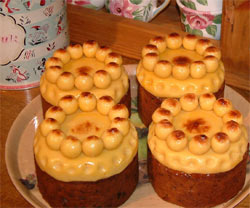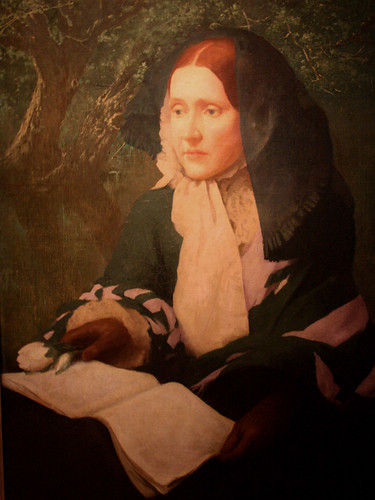The Catholic Mother's Day celebration became part of the liturgical calendar as Laetare Sunday, the fourth Sunday in Lent to honor the Virgin Mary and the "mother church". Laetare means "Rejoice" in Latin.During the sixteenth century, people returned to their mother church for a service to be held on Laetare Sunday. This was either a large local church, or more often the nearest Cathedral. Anyone who did this was said to have gone "a-mothering".
Another name attributed to this festival is Simnel Sunday. Simnel Sunday is named after the practice of baking Simnel cakes to celebrate the reuniting of families during the austerity of Lent. Recipe Mothering Sunday as it was also known was a time put aside for relaxation and enjoyment during the long Lenten fast. It was kind of a break or holday from fasting. Young British servant girls who worked away from home were given time off by their masters to visit their mothers on this special day and they would bake a Simnel cake to present to their Mothers as a gift.
Earlier traditions saw the cake being eaten on Simnel Day but it soon became customary to keep the cake for a week until Easter Sunday. Keeping the cake fresh for the week leading up to Easter was seen to be a test of the cook's culinary skills; she was considered to be a good cook if the cake tasted good, a week later, on Easter Sunday.
 Catholics and Episcoplaians brought versions of these traditons to the New World.
Catholics and Episcoplaians brought versions of these traditons to the New World.Mother's Day in the United States of America
Julia W ard Howe, author of the "Battle Hymn of the Republic", organized a day for mothers dedicated to peace. It is a landmark event in the history of Mother's Day in the United States. She proposed an annual Mothers' Day for Peace. Committed to abolishing war, Howe wrote: "Our husbands shall not come to us reeking with carnage... Our sons shall not be taken from us to unlearn all that we have been able to teach them of charity, mercy and patience. We women of one country will be too tender of those of another country to allow our sons to be trained to injure theirs".
ard Howe, author of the "Battle Hymn of the Republic", organized a day for mothers dedicated to peace. It is a landmark event in the history of Mother's Day in the United States. She proposed an annual Mothers' Day for Peace. Committed to abolishing war, Howe wrote: "Our husbands shall not come to us reeking with carnage... Our sons shall not be taken from us to unlearn all that we have been able to teach them of charity, mercy and patience. We women of one country will be too tender of those of another country to allow our sons to be trained to injure theirs". ......................................
Mothers' Day Proclamation: Julia Ward Howe, Boston, 1870
Arise, then, women of this day! Arise all women who have hearts,
whether our baptism be that of water or of fears!
Say firmly: "We will not have great questions decided by
irrelevant agencies. Our husbands shall not come to us, reeking
with carnage, for caresses and applause. Our sons shall not be
taken from us to unlearn all that we have been able to teach
them of charity, mercy and patience.
We women of one country will be too tender of those of another
country to allow our sons to be trained to injure theirs. From
the bosom of the devastated earth a voice goes up with our own.
It says "Disarm, Disarm! The sword of murder is not the balance
of justice."
Blood does not wipe our dishonor nor violence indicate possession.
As men have often forsaken the plow and the anvil at the summons
of war, let women now leave all that may be left of home for a
great and earnest day of counsel. Let them meet first, as women,
to bewail and commemorate the dead.
Let them then solemnly take counsel with each other as to the
means whereby the great human family can live in peace, each
bearing after their own time the sacred impress, not of Caesar,
but of God.
In the name of womanhood and of humanity, I earnestly ask that a
general congress of women without limit of nationality may be
appointed and held at some place deemed most convenient and at
the earliest period consistent with its objects, to promote the
alliance of the different nationalities, the amicable settlement
of international questions, the great and general interests of
peace.
Julia Ward Howe
Boston
1870
Beginning 1872 and for the next 30 years, Americans celebrated Mothers' Day for Peace on June 2. Many middle-class women in the 19th century believed that they bore a special responsibility as mothers to care for the casualties of society and to turn America into a more civilized nation. They played a leading role in the abolitionist movement to end slavery. They launched successful campaigns against lynching and consumer fraud and fought for improved working conditions for women, protection for children, public health services and social welfare assistance to the poor. People like Glen Beck would hate them.To these activists, the connection between motherhood and the fight for social and economic justice seemed self-evident. Ann Maria Reeves Jarvis is a fine example of this sort of activist 19th century woman. It is because her daughter , Anna, wished to honor her work that Mother's Day is celebrated on the Second Sunday in May in the United States.
Ann Maria Reeves Jarvis and her brother, a doctor, organized a series of Mothers' Day Work Clubs in five Virginian cities to improve health and sanitary conditions. She actively sought to improve the health of her community. Among other services, the clubs raised money for medicine, hired women to work for families in which the mothers suffered from tuberculosis, and inspected bottled milk and food. In 1860, local doctors supported the formation of clubs in other towns and these ideas spread. Ann Jarvis urged the Mothers' Day Work Clubs to declare their neutrality and provide relief to both Union and Confederate soldiers. The clubs treated the wounded and regularly fed and clothed soldiers stationed in the area. Jarvis also managed to preserve an element of peace in a community being torn apart by political differences. She actively sought to bring peace to her community.
Tensions increased as both Union and Confederate soldiers returned at war's end. In the summer of 1865, Ann Jarvis organized a Mothers' Friendship Day to bring together soldiers and neighbors of all political beliefs. The event was a great success despite the fear of many that it would erupt in violence. Mothers' Friendship Day was an annual event for several years. Perhaps it's return would bring together the disparate parts of our modern body politic.
The first Mother's Day observance was a church service honoring her mother, Ann. Services were held at Andrews Methodist Episcopal Church in Grafton, which is now the International Mothers Day Shrine at which Anna handed out her mother's favorite flowers, white carnations, because they represent sweetness, purity, and patience. Anna was successful in getting West Virginia Governor Glassock to proclaim a statewide Mother's Day in 1910. President Woodrow Wilson finally proclaimed the second Sunday in May as a national holiday in honor of mothers in 1914.

Anna Jarvis had worked in an insurance company’s advertising department, and used that experience to promote her Mother's Day by incorporating an association in 1912, registering trademarks for the white carnation symbol and the phrases “second Sunday in May” and “Mother’s Day.” Note the apostrophe: the holiday was to be personal and possessive, not collective and plural as in the previously observed Mothers' Day For Peace. The coming commercialization of Mother’s Day should have been no surprise to Miss Jarvis; her ally in creating Mother's Day and fellow Philadelphian, John Wanamaker had become wealthy by inventing the department store and modern advertising. Wanamaker’s department stores gave free carnations to women shoppers on the holiday, which was observed at a ceremony in the Wanamaker Store Auditorium on May 10, 1908, where Miss Javis spoke to the crowd for over an hour.
By 1920 Politicians and businessmen eagerly embraced the idea of celebrating mothers and motherhood. As the Florists' Review, the industry's trade journal, bluntly put it, "This was a holiday that could be exploited." America was becoming a consumer culture with mother's charging the way. This holiday took on the expressions of a changing cultural system.
The new advertising industry quickly taught Americans how to honor their mothers - by buying flowers. Outraged by florists who were selling carnations for the outrageous price of $1 a piece, Ann Jarvis daughters undertook a campaign against those who "would undermine Mother's Day with their greed." But they fought a losing battle. Within a few years, the Florists' Review triumphantly announced that it was "Miss Jarvis who was completely squelched." Anna and her sister Ellsinore spent their family inheritance campaigning against the holiday. Both died in poverty. According to her New York Times obituary, Jarvis became embittered because too many people sent their mothers a printed greeting card. As she said,
A printed card means nothing except that you are too lazy to write to the woman who has done more for you than anyone in the world. And candy! You take a box to Mother—and then eat most of it yourself. A pretty sentiment! The "grafters" who purveyed such trifles would, she said, "take the coppers off a dead mother's eyes."
Anna Marie Jarvis never married and had no children. Growing blind and deaf, she was finally moved to a nursing home—where she was secretly supported by the florists she so despised until she died in 1948.
Regardless of Jarvis' concerns, Mother's Day has flourished in the United States. Flower sales have grown at a 6% annual rate, and now represent a $102 billion global market. The second Sunday of May has become the busiest restaurant day of the year, surpassing even Valentine's Day.

* The Golden Rule: "Whatsoever ye would that others should do for your mother if she were in need, and whatsoever your mother would do for the needy if she had the opportunity, do in her name and in her honor for other mothers and their children, victims of present-day maladjustments."